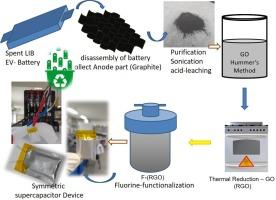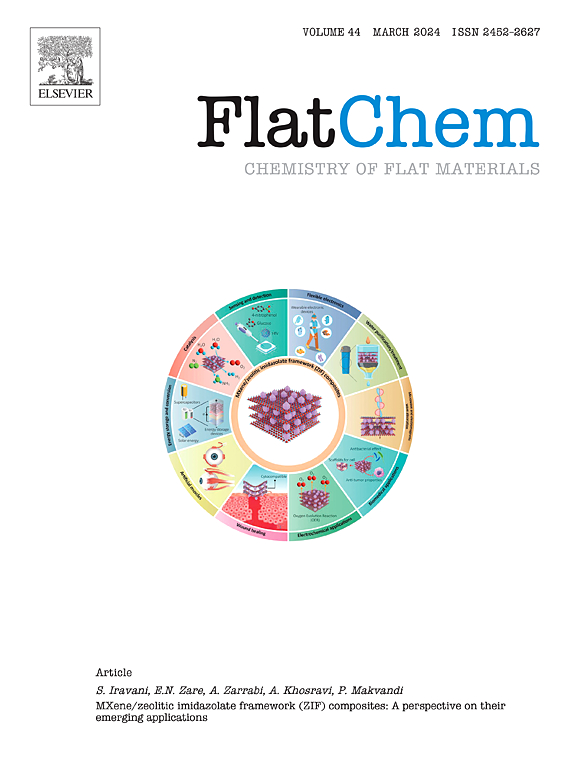实现对称超级电容器器件性能的氟化还原氧化石墨烯纳米片
IF 5.9
3区 材料科学
Q2 CHEMISTRY, PHYSICAL
引用次数: 0
摘要
本研究通过简单的再生过程,探索了利用废旧锂离子电池阳极(石墨)制造对称能源装置的潜力。具体来说,研究了使用从废电池中提取的掺氟还原氧化石墨烯(RGO)纳米片作为对称超级电容器(SC)装置的基础。为了增强电化学储能能力,采用了一种简便的水热技术来合成氟化石墨烯。根据能量色散光谱(EDS)谱分析,掺氟水平为 2.94 at.% 的硼的存在证实了石墨烯片的氟化已成功实现。对 F-RGO 电极进行的电化学分析表明,该电极具有双层电容。此外,在三电极系统中,当电流密度为 1 A/g 时,F-RGO 电极的最大比电容为 207F/g。采用 F-RGO 的双电极对称装置在 1 A/g 电流密度下的比电容为 54F/g。此外,电化学阻抗测量结果表明,F-RGO 的电荷转移电阻(Rct)值较低,具体为 8.63 Ω,这表明其电化学性能得到了改善。因此,在 RGO 纳米片中掺入氟原子有助于提高 F-RGO 的比电容和整体优异的电化学性能,F-RGO 是一种用于高性能 SC 储能电极的高电化学活性材料。本文章由计算机程序翻译,如有差异,请以英文原文为准。

Fluorinated reduced graphene oxide nanosheets for symmetric supercapacitor device performance
This study explores the potential of using spent lithium-ion battery anodes (graphite) for fabricating symmetric energy devices through a simple regeneration process. Specifically, the use of fluorine-doped reduced graphene oxide (RGO) nanosheets derived from waste batteries as the basis for a symmetric supercapacitor (SC) device is investigated. To enhance the electrochemical energy storage capabilities, a facile hydrothermal technique is employed to synthesize fluorinated graphene. Fluorination of the graphene sheets is successfully realized, as confirmed by the presence of boron with a 2.94 at.% fluorine-doped level, according to the Energy dispersive spectroscopy (EDS) spectrum analysis. Electrochemical analysis of the F-RGO electrode performance consistent with electric double-layer capacitance. Moreover, with a three-electrode system, the F-RGO electrode achieves a maximum specific capacitance of 207F/g under a current density of 1 A/g. A two-electrode symmetric device employing F-RGO exhibits a specific capacitance of 54F/g at 1 A/g. Furthermore, electrochemical impedance measurements demonstrate low charge transfer resistance (Rct) values, specifically 8.63 Ω for F-RGO, signifying improved electrochemical performance. Thus, fluorine atomic doping in RGO nanosheets contributes to the improvements of the specific capacitance and overall superior electrochemical performance of F-RGO, and F-RGO is a highly electrochemical active material for high-performance energy storage electrodes for SCs.
求助全文
通过发布文献求助,成功后即可免费获取论文全文。
去求助
来源期刊

FlatChem
Multiple-
CiteScore
8.40
自引率
6.50%
发文量
104
审稿时长
26 days
期刊介绍:
FlatChem - Chemistry of Flat Materials, a new voice in the community, publishes original and significant, cutting-edge research related to the chemistry of graphene and related 2D & layered materials. The overall aim of the journal is to combine the chemistry and applications of these materials, where the submission of communications, full papers, and concepts should contain chemistry in a materials context, which can be both experimental and/or theoretical. In addition to original research articles, FlatChem also offers reviews, minireviews, highlights and perspectives on the future of this research area with the scientific leaders in fields related to Flat Materials. Topics of interest include, but are not limited to, the following: -Design, synthesis, applications and investigation of graphene, graphene related materials and other 2D & layered materials (for example Silicene, Germanene, Phosphorene, MXenes, Boron nitride, Transition metal dichalcogenides) -Characterization of these materials using all forms of spectroscopy and microscopy techniques -Chemical modification or functionalization and dispersion of these materials, as well as interactions with other materials -Exploring the surface chemistry of these materials for applications in: Sensors or detectors in electrochemical/Lab on a Chip devices, Composite materials, Membranes, Environment technology, Catalysis for energy storage and conversion (for example fuel cells, supercapacitors, batteries, hydrogen storage), Biomedical technology (drug delivery, biosensing, bioimaging)
 求助内容:
求助内容: 应助结果提醒方式:
应助结果提醒方式:


